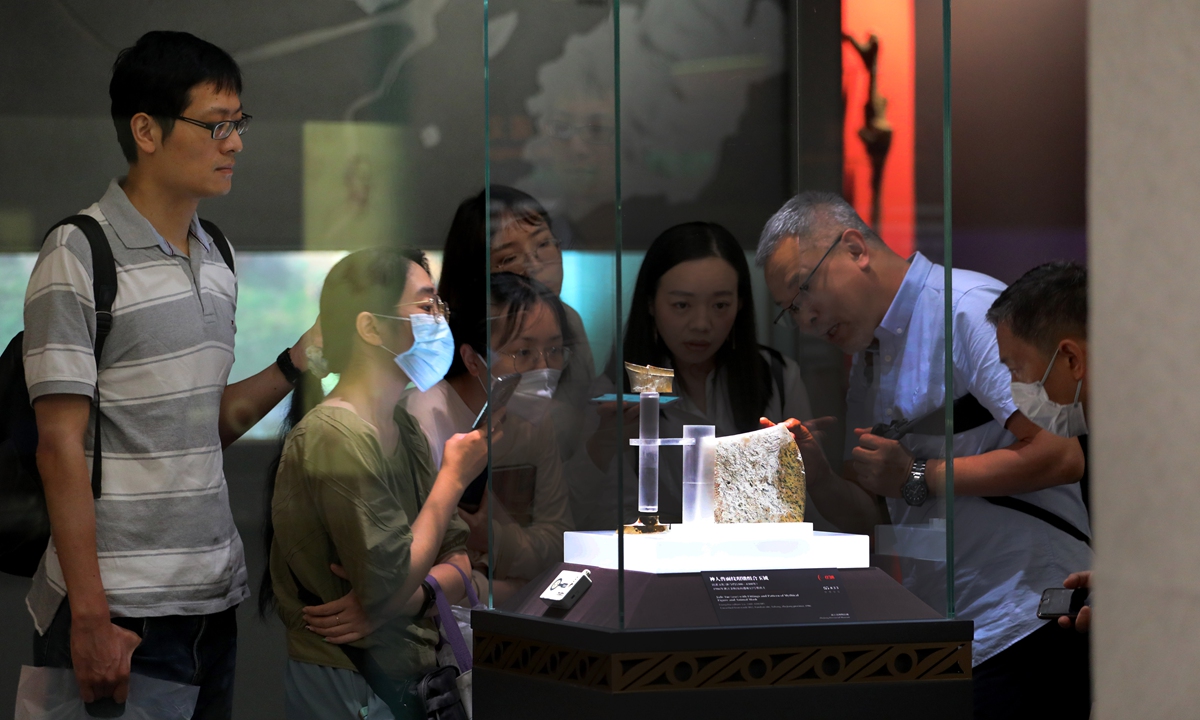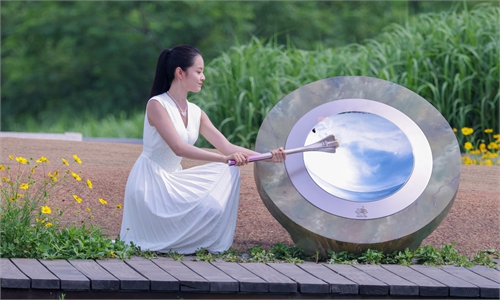ARTS / CULTURE & LEISURE
Spotlight on Neolithic civilization
Shanghai exhibition explores prehistoric culture in E.China

Visitors look at a precious relic, a 5,000-year-old jade yue (axe), at the Shanghai Museum on June 18, 2023. Photo: Chen Xia/Global Times
A 6.5-kilogram jade cong (a rectangular tube) is placed in the center of the exhibition hall under soft light. Its four sides and corners are vividly carved in relief with symmetrical motifs of human and animal faces; some of the lines carved along its surface are as thin as a human hair.It's hard to imagine that this jade artifact, reflecting the superb carving skill of its maker, was made some 5,000 years ago.
This rare jade cong is just one of the many precious 5,000-year-old cultural relics on display in Shanghai. Together, they show the public the splendid prehistoric civilization that took shape in eastern China, standing as compelling evidence for the continuous and uninterrupted growth of ancient China as a great civilization, said Chu Xiaobo, director of the Shanghai Museum.
Kicking off at the Shanghai Museum on Tuesday, the exhibition The Proof of Early China: The Civilizations of Songze and Liangzhu gathers 358 unearthed relics from the collections of 19 museums and archaeological institutions across China.
One third of the relics have never been put on public display before.
Dating back to around 5,800 to 4,300 years ago, the relics were discovered in the lower reaches of the Yangtze River region, one of the richest and developed areas in both ancient and modern China.
The lower reaches of the Yangtze River region stands as a quintessential representation of China's early regional civilizations, embodying their pinnacle, said Chen Jie, head curator of the exhibition and deputy director of the Shanghai Museum.
"Through these carefully selected exhibits, we want to show our visitors four main characteristics of China's early civilizations - the civilizations of ancient states, rice cultivation, handicraft industry and jade," Chen told the Global Times at the exhibition's preview on Monday.
These are solid evidence of the existence of China's glorious civilization that has spanned more than 5,000 years, Chen noted.
The exhibition focuses on the two main cultures of early civilization in the lower reaches of the Yangtze River region: The Songze culture and Liangzhu culture.
The Songze culture (5,800-5,300 years ago), named after the Songze ancient cultural site discovered in a Shanghai suburb, was an important stage in the development of Neolithic culture in China.
At the exhibition, various exquisite utensils on display bring visitors back to the remote Songze era, demonstrating the brilliant handicraft techniques of that time.
The Double-layered Pottery Pot with Design and Petal-shaped Foot, for instance, is decorated with delicate triangles, circles and petal patterns on its body and bottom, showing the aesthetic tastes of the Songze people.
The Liangzhu culture (5,300-4,300 years ago) is a highlight of the late Neolithic culture. Many people in and outside China learned about the Liangzhu culture in 2019, when UNESCO listed the Archaeological Ruins of Liangzhu City in Hangzhou, Zhejiang Province, as a World Heritage Site.
Last week, the Archaeological Ruins of Liangzhu City once again became a familiar name as the venue for igniting the Hangzhou Asian Games flame.
The Liangzhu people established the first-ever regional "state" in China and even East Asia and profoundly influenced the diverse yet interconnected growth of Chinese civilization.
The popularity of jade was a main characteristic of the Liangzhu culture. The people of this era utilized jade to delineate social hierarchies, distinguish status and symbolize power. This gave rise to an array of jade ritual objects that were accompanied by an intricate ritual system, introduced Fang Xiangming, director of Zhejiang Institute of Cultural Relics and Archaeology, a co-organizer of the exhibition.
At Monday's preview, Fang mentioned one of the most precious exhibits in the hall: the Jade yue with Fittings and Pattern of Mythical Figure and Animal Mask. The jade yue (axe) is decorated with well-designed patterns of birds and human and animal faces.
"Early on, an axe was a symbol of violence, only used for killing," Fang told the Global Times.
"But in the Liangzhu culture, it turned into sort of an exquisitely decorated scepter, a ritual item of the ruling class."
This is the second show in the Shanghai Museum's The Essence of China series, which focuses on major Chinese archaeological findings. Its first show, The Making of China: the Civilization of the Xia, Shang and Zhou Dynasties, was held in 2022.
The exhibition is set to run until October 8.




